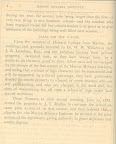 |
In 1968 Warner Brothers released their film adaptation of Carson McCuller’s classic novel, The Heart Is a Lonely Hunter. The cast included a young Alan Arkin and a equally young Sondra Locke and Stacy Keach, among others. Arkin was nominated for an Academy Award for his role as Singer in the film; he did win the New York Film Critics Award as Best Actor.
Singer is a deaf-mute who uses sign language to communicate with his fellow deaf-mute friend (played by Chuck McCann) who is also a mentally-challenged man-child who is constantly getting into trouble with the law. His guardian (an uncle) finally has him committed to the state mental hospital.
Shot mainly in Selma, Alabama, I was surpised to see that the first ten minutes of the film were actually done in Marion! The Perry County Courthouse and various businesses around the square (most of which no longer exist) are featured in several scenes. The biggest surpise, at least to a relative newcomer to the area like myself, was seeing a thriving downtown Marion during the late 1960s.
A memorable scene in the movie shows the mentally-ill character breaking a bakery window in Marion (setting off the alarm) and gorging himself on pasteries while stealing the bride and groom off the top of a wedding cake. Two policemen arrive to arrest their “best customer.” Singer (Alan Arkin) arrives on the scene just a bit too late to help his friend.
The bakery window today is Jim’s Artifacts across from the Perry County Courthouse.
 |
The final scene in Marion shows Singer (Arkin) putting his mentally-ill friend on a bus across from Nathan Harris’ bound for the state hospital. The steeple of Siloam Baptist Church looms in the background above the bus. The bus then turns left past the old hotel.
The scene of the last scene filmed in Marion!
 |
The following two photographs of the MMI Chapel were made by an old friend of mine, Larry Hice, some thirty-odd years ago during one of our many “road trips” around Alabama from Huntsville. I thought you would enjoy seeing them.
 |
 |
These two scans are from the very first Marion Military Institute catalogue of 1888, published after the close of the first session, 1887-1888. Page two shows that there were both high school and college level students in the Corps from the very beginning. The article on pages 2-3 mentions that the school first opened on October 4, 1887, and that the Trustees rented the campus property to James T. Murfee on June 12, 1888, for the sole purpose of conducting the school on the same plan as the first session.
 |
 |
Finally, as a follow-up to the blog on Henry and Julia Tutwiler’s famed Green Springs School near Havana, Alabama, this tiny sign is the only remaining evidence on a public road that Green Springs (a former resort before it became the school) ever existed. None of the buildings remain and the private property is fenced and gated and utilized primarily for logging and hunting.
The little sign is near a lonely intersection in Hale County
 |